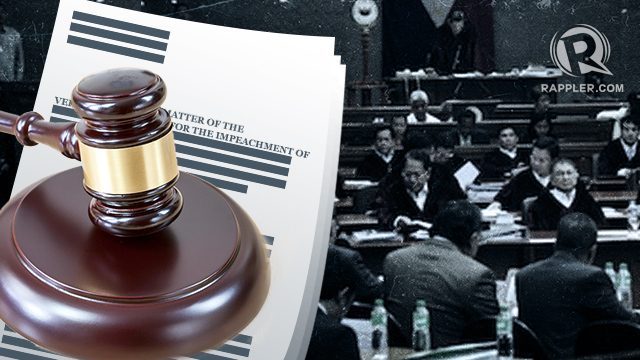SUMMARY
This is AI generated summarization, which may have errors. For context, always refer to the full article.

MANILA, Philippines (UPDATED) – Some top officials, including the President of the Philippines, enjoy “immunity from suit” while in office.
But this does not get them completely off the hook.
The 1987 Constitution lays down rules to make them accountable through the process of impeachment.
Who can be impeached
Section 2, Article XI of the Constitution says that the President, Vice President, members of the Supreme Court, members of constitutional commissions, and the Ombudsman may be removed from office via impeachment.
Only one complaint can be filed against an impeachable official per year – if an impeachment complaint does not prosper, a second complaint cannot be filed within the same year.
Who can file
Any member of the House of Representatives can initiate a verified impeachment complaint. Any Filipino citizen may also file a complaint, which should be endorsed by a House member.
At least one-third of House members may likewise file a verified complaint or resolution of impeachment. Given the 292 members of the House at present, this translates to at least 97 members.
Grounds for impeachment
An impeachment complaint can be filed on any of the following grounds:
- Culpable violation of the Constitution
- Treason
- Bribery
- Graft and corruption
- Other high crimes
- Betrayal of public trust
Receipt of complaint
A verified impeachment complaint should be filed with the Office of the Secretary General of the House. It would be immediately referred to the Speaker.
Within 10 session days from receipt, the Speaker shall include it in the House’s Order of Business. In relation to the complaint filed against President Rodrigo Duterte on March 16, this means Speaker Pantaleon Alvarez has until May 23 to include it in the Order of Business.
After inclusion, the complaint should then be referred to the House committee on justice within 3 session days after. With respect to the Duterte complaint, this means it can be referred to the committee up to May 30.
The House justice committee shall then determine whether the complaint is sufficient in form and substance, and if there is probable cause to pursue it. A majority vote of justice committee members will be needed to decide there is probable cause.
From House to Senate
After conducting hearings, the justice committee should file, within 60 days from referral, a formal resolution to the House plenary regarding the impeachment complaint. If there is probable cause, the committee will also submit a resolution setting the Articles of Impeachment.
At least one-third of House members voting for the Articles of Impeachment will be needed for it to be endorsed to the Senate. This is equivalent to 97 members of the current House.
Impeachment trial
The Senate will try and decide all cases of impeachment in a full-blown trial.
In case the President is on trial, the Chief Justice of the Supreme Court will preside over the proceedings.
If two-thirds of Senate members vote to convict an impeachable official as outlined in the Articles of Impeachment, he or she will be removed from office. This translates to 16 out of the 24 current members of the Senate. – Rappler.com
Add a comment
How does this make you feel?
There are no comments yet. Add your comment to start the conversation.